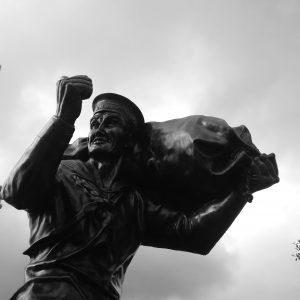- Author
- A.N. Other
- Subjects
- None noted
- Tags
-
- RAN Ships
- None noted.
- Publication
- March 2018 edition of the Naval Historical Review (all rights reserved)
By Gavin Ryan
Gavin Ryan a retired RAN leading signalman is convenor and director of The Australian Sailor Pty Ltd, an important project to provide a suitable mark of respect to men and women who served our country at sea. Gavin and fellow directors LCDR Brett Lane RANR, Mal Hughes OAM, CDRE Bob Trotter OAM RAN Rtd and Mike Megaw have been involved with this project for over ten years.
The vision
Australia has no national monument to the men and women who served our country at sea and nothing to honour the contribution of the thousands who discovered, settled, developed and defended our homeland. The Australian Sailor Monument aims to provide long overdue recognition for this service.
Financial support has been received from the Commonwealth and Western Australian Governments, the Royal Australian Navy and Lotterywest for a total of $1.1 million. The project is now seeking support from the private sector, corporations and individuals for a further $1million to complete the work.
The artists and their model
Award winning artists Charles Smith and Joan Walsh-Smith, were commissioned to design a suitable monument. Well known as the creators of the evocative and moving memorial to HMAS Sydney in Geraldton they have imbued the same powerful emotion into the Australian Sailor Monument, an imposing bronze sculpture, which on its base stands 3.6 meters high.

The centrepiece is a bronze sculpture of a young man in naval uniform taking his first steps up the gangway. The pose captures him looking back briefly at those gathered to say goodbye. Smiling and striding purposely into the unknown, raising a hand in a final gesture of farewell. A moment in time when the sea beckons and the safety of the shore is left behind.
Jack Tar was once a name synonymous with all sailors and the model used in this case is simply known as ‘Jack’. An early 1950s round-rig uniform and kitbag was discovered but as we have grown much larger in the intervening 60+ years finding someone with appropriate features and slim enough to fit into it presented a problem. Eventually a friend of the artists, whose day job is working as an engineer, was persuaded to don the uniform and became ‘Jack’.
Unveiling ceremony
In its temporary resting place at Elizabeth Quay on the foreshore of the Swan River the statue was unveiled by the Premier of Western Australia, The Honourable Mark McGowan MLA, on 18 September 2017. But this is just the start of the journey as ‘Jack’ is intended to become part of a much grander overall structure sited where land and sea meet at the entrance to the Port of Fremantle.
The monument in its final glory
The organisers are still raising funds for completion of the podium to be sited at Rous Head. The sculpture will rest on foundations laid more than a century ago as part of the construction of Fremantle Harbour – a harbour which has stood the test of time in peace and in war. The land for the site has been provided by Fremantle Ports and, importantly for visitors, sits directly opposite the renowned West Australian Maritime Museum.
The interactive monument is set on a compass-rose motif of stone and granite forming a solar-clock face. The central shaft casts a ship shaped shadow on the clock face recording the passage of time. Symbolic bollards mark the hour lines and free-standing history walls provide a canvas for images and text honouring our maritime heritage. This great statue will dominate the entrance to the harbour and be clearly visible to ships approaching the coast.
In the meantime ‘Jack’ remains at Elizabeth Quay until his podium on Rous Head is completed. He will then make a final voyage down river aboard a barge, accompanied with due ceremony by a flotilla of small craft, to his permanent mooring. As ‘Jack’ is getting restless hopefully all will be completed later this year.
Note:Perhaps our friends in the West should not be too disheartened at a few delays, noting that the Cenotaph in Sydney’s Martin Place was officially dedicated in August 1927 but it was not until February 1929 that its two bronze sentinels, a soldier and a sailor (another leading signalman) arrived to stand guard.




